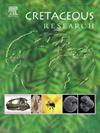上侏罗统至下白垩统Khorat群的分离兽脚亚目牙齿:对泰国兽脚亚目多样性的启示
IF 1.7
3区 地球科学
Q1 GEOLOGY
引用次数: 0
摘要
在泰国上侏罗统至下白垩统的Khorat群中,发现了大量的脊椎动物遗骸。然而,尽管发现了许多牙齿材料,但只有有限数量的研究集中在这些孤立牙齿的形态和分类上。本研究对泰国东北部呼叻高原19个地点采集的112颗兽脚亚目分离牙齿进行了调查。根据牙齿特征将这些牙齿分为五种形态。他们是根据对兽脚亚目恐龙的四个分支的分类和鉴别分析来确定的:长棘龙科、暴龙科、棘龙科和异特龙。这些牙齿证据为了解泰国晚侏罗世到早白垩纪的兽脚亚目动物多样性提供了重要的见解。具体而言,晚侏罗世至早白垩世Phu Kradung组显示了长棘龙类和基暴龙类的广泛存在,而Sao Khua组和Khok Kruat组显示了早白垩世异特龙类和棘龙类的优势转变。在后来的地层中,巨棘龙类和基底暴龙类的缺失表明了一种动物更替,异特龙类和棘龙类变得更加普遍,这与欧亚大陆兽脚亚目动物组成的变化相一致。此外,这一贡献还揭示了侏罗纪-白垩纪交界期欧亚兽脚亚目动物的更替模式,这可能与恐龙进化关键时期食草恐龙的变化有关。本文章由计算机程序翻译,如有差异,请以英文原文为准。
Isolated theropod teeth from the Upper Jurassic to Lower Cretaceous Khorat Group: Implications for theropod diversity in Thailand
Isolated theropod teeth are notably abundant of vertebrate remains within the Upper Jurassic to Lower Cretaceous Khorat Group of Thailand. However, despite the discovery of numerous dental materials, only a limited number of studies have focused on the morphology and taxonomy of these isolated teeth. This study investigated 112 isolated theropod teeth were retrieved from 19 localities on the Khorat Plateau in Northeastern Thailand. These teeth were divided into five morphotypes based on dental characteristics. They were identified based on cladistic and discriminant analyses that recovered four clades of theropod dinosaurs: Metriacanthosauridae, Tyrannosauroidea, Spinosauridae, and Allosauria. This dental evidence provide significant insights into the theropod diversity in Thailand during the Late Jurassic to Early Cretaceous. Specifically, the Late Jurassic to Early Cretaceous Phu Kradung Formation revealed an extended presence of metriacanthosaurids and basal tyrannosauroids, while the Sao Khua and Khok Kruat Formations indicated a shift towards allosaurian and spinosaurid dominance during the Early Cretaceous. The absence of metriacanthosaurids and basal tyrannosauroids in later formations suggests a faunal turnover, with allosaurians and spinosaurids becoming more prevalent, aligning with the changes in theropod faunal composition across Eurasia. Furthermore, this contribution suggested the faunal turnover pattern in the Eurasian theropods during the Jurassic-Cretaceous boundary interval, which might have been related to the change in herbivorous dinosaurs during this crucial timeframe of dinosaur evolution.
求助全文
通过发布文献求助,成功后即可免费获取论文全文。
去求助
来源期刊

Cretaceous Research
地学-地质学
CiteScore
4.10
自引率
19.00%
发文量
235
审稿时长
12 weeks
期刊介绍:
Cretaceous Research provides a forum for the rapid publication of research on all aspects of the Cretaceous Period, including its boundaries with the Jurassic and Palaeogene. Authoritative papers reporting detailed investigations of Cretaceous stratigraphy and palaeontology, studies of regional geology, and reviews of recently published books are complemented by short communications of significant new findings.
Papers submitted to Cretaceous Research should place the research in a broad context, with emphasis placed towards our better understanding of the Cretaceous, that are therefore of interest to the diverse, international readership of the journal. Full length papers that focus solely on a local theme or area will not be accepted for publication; authors of short communications are encouraged to discuss how their findings are of relevance to the Cretaceous on a broad scale.
Research Areas include:
• Regional geology
• Stratigraphy and palaeontology
• Palaeobiology
• Palaeobiogeography
• Palaeoceanography
• Palaeoclimatology
• Evolutionary Palaeoecology
• Geochronology
• Global events.
 求助内容:
求助内容: 应助结果提醒方式:
应助结果提醒方式:


